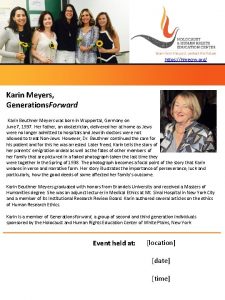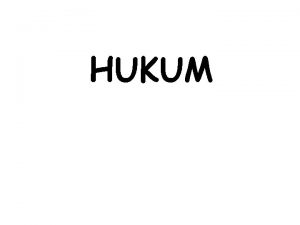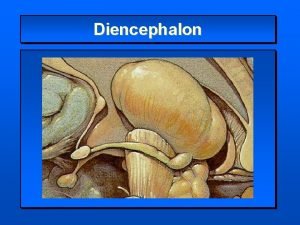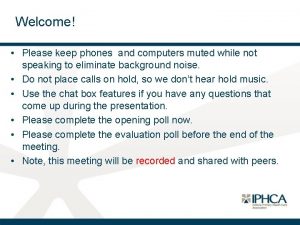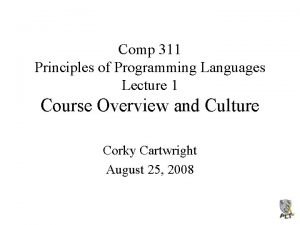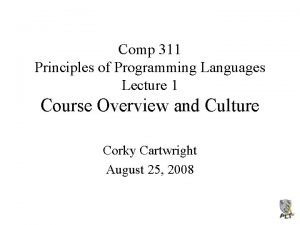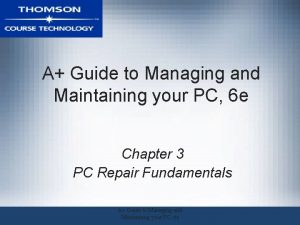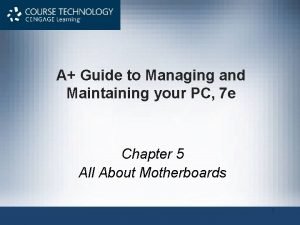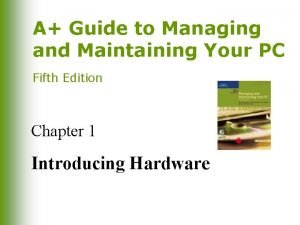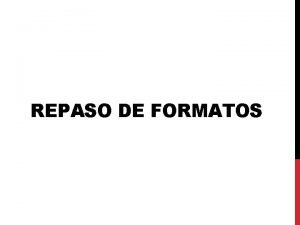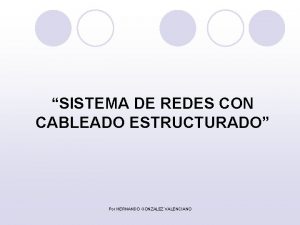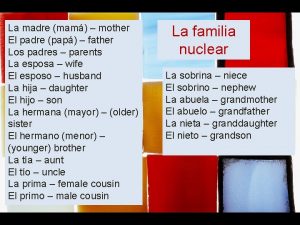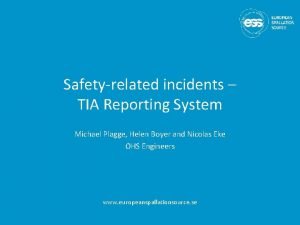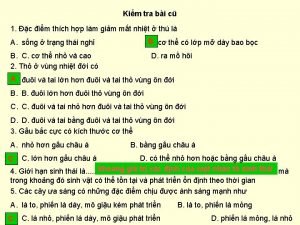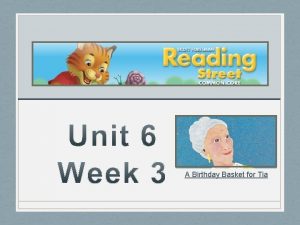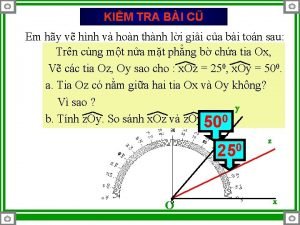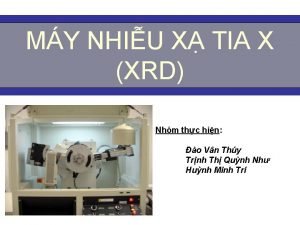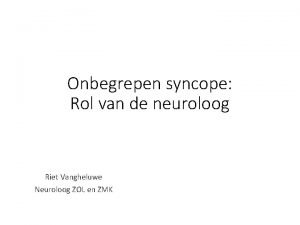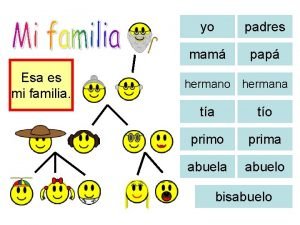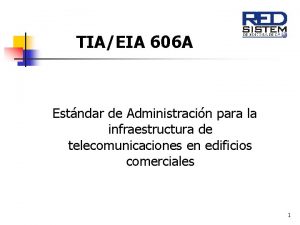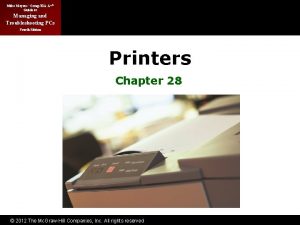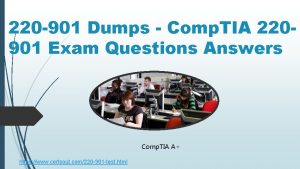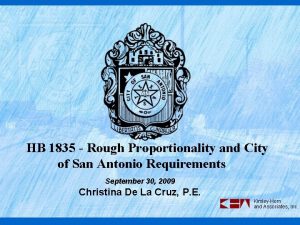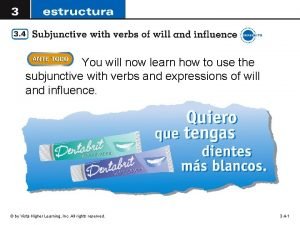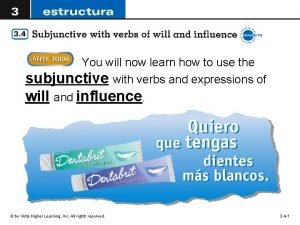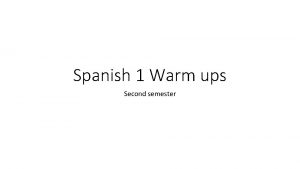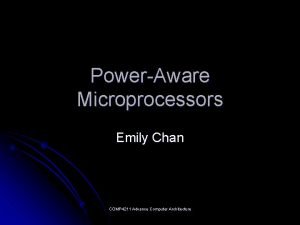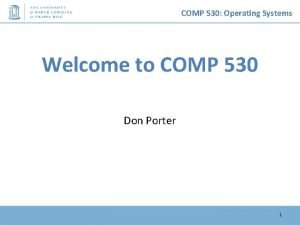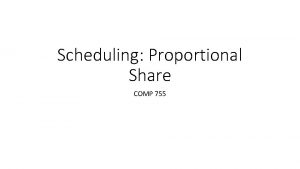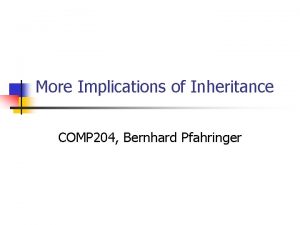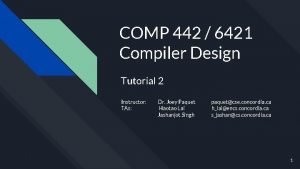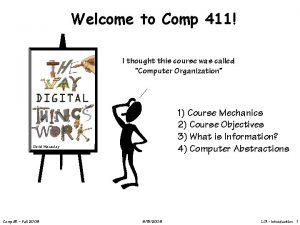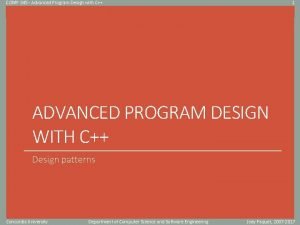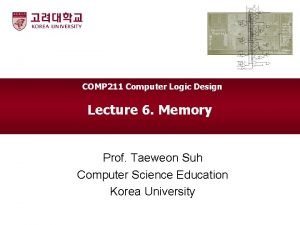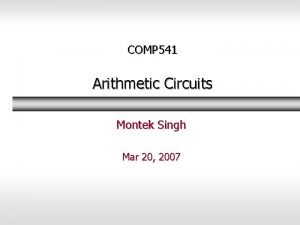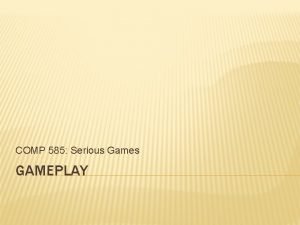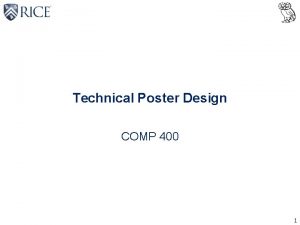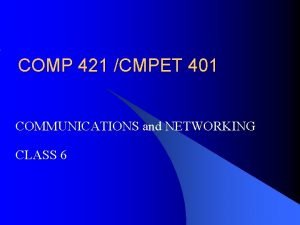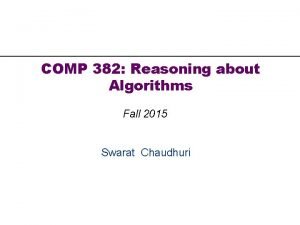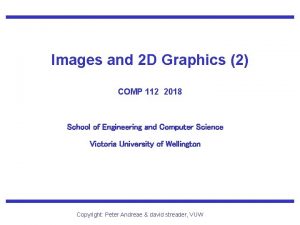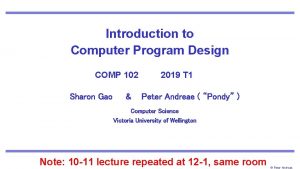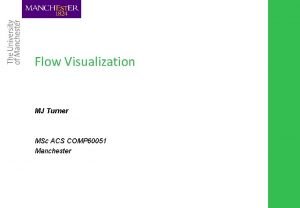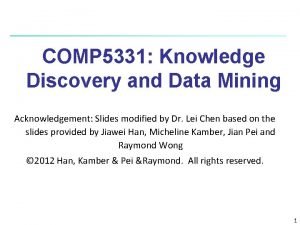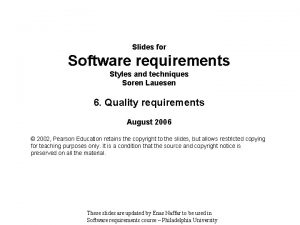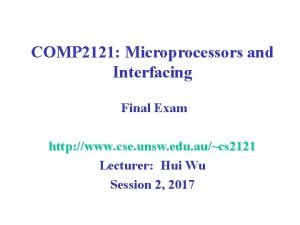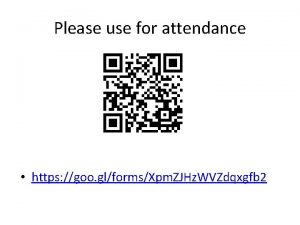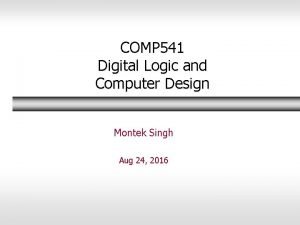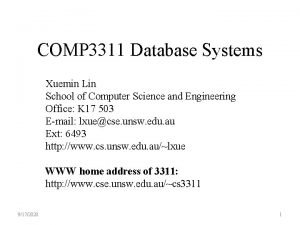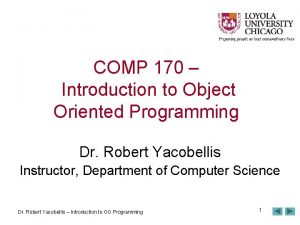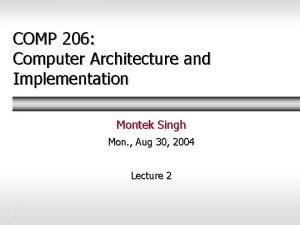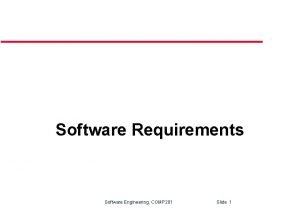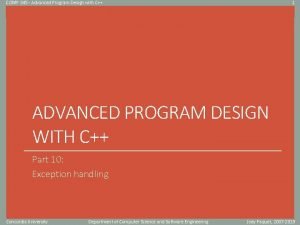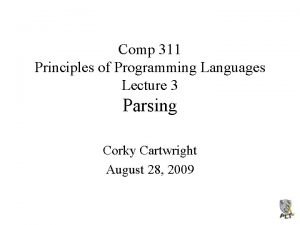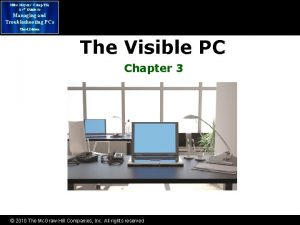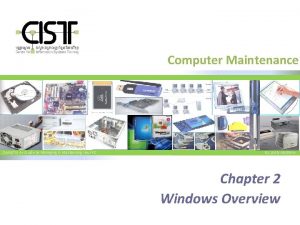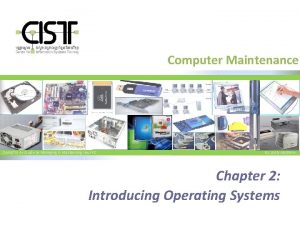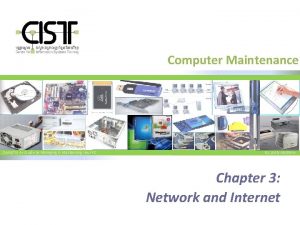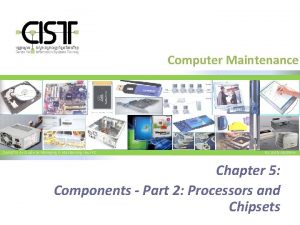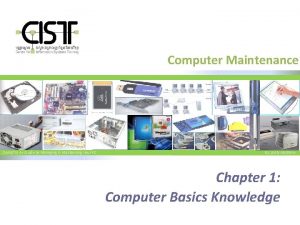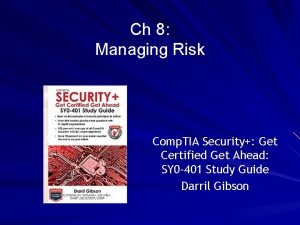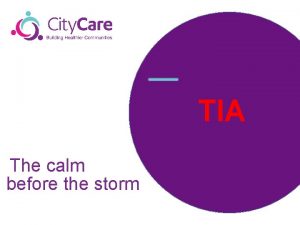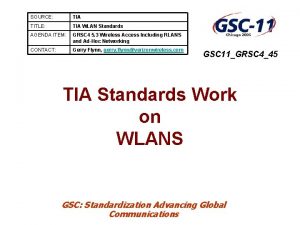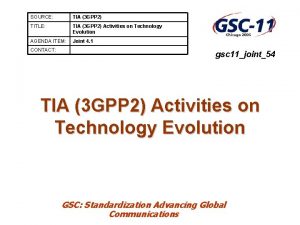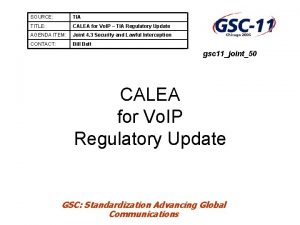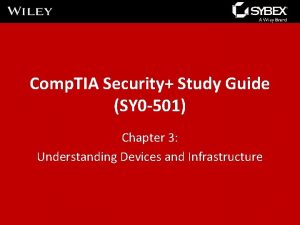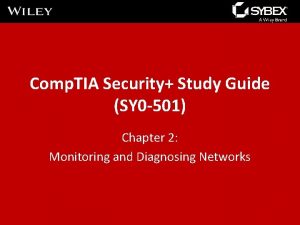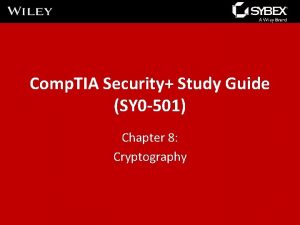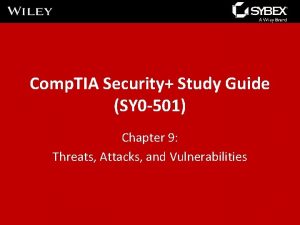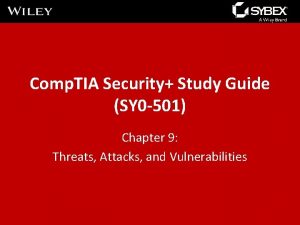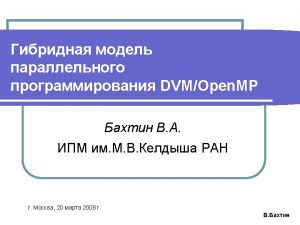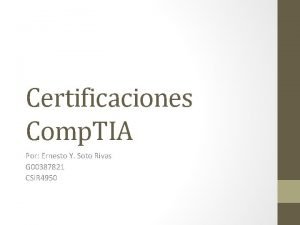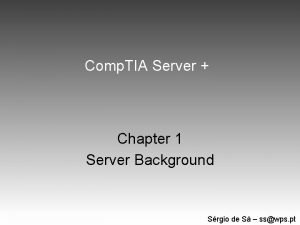Mike Meyers Comp TIA A Guide to Managing








































































































- Slides: 104

Mike Meyers’ Comp. TIA A+® Guide to Managing and Troubleshooting PCs Fourth Edition Printers Chapter 28 © 2012 The Mc. Graw-Hill Companies, Inc. All rights reserved

Mike Meyers’ Comp. TIA A+® Guide to Managing and Troubleshooting PCs Overview Fourth Edition • In this chapter, you will learn how to – Describe current printer technologies – Explain the laser printing process – Install a printer on a Windows PC – Recognize and fix basic printer problems © 2012 The Mc. Graw-Hill Companies, Inc. All rights reserved

Mike Meyers’ Comp. TIA A+® Guide to Managing and Troubleshooting PCs Six Types of Printers Fourth Edition – Impact printers – Thermal printers – Inkjet printers – Solid ink printers – Dye-sublimation printers – Laser printers © 2012 The Mc. Graw-Hill Companies, Inc. All rights reserved

Mike Meyers’ Comp. TIA A+® Guide to Managing and Troubleshooting PCs Impact Printers Fourth Edition • Impact printers leave an image on the paper – Physically strike an inked ribbon against the surface of the paper – Relatively slow and noisy – Used for multipart forms • Point of sale receipts • Offices © 2012 The Mc. Graw-Hill Companies, Inc. All rights reserved

Mike Meyers’ Comp. TIA A+® Guide to Managing and Troubleshooting PCs Dot-Matrix Printers Fourth Edition • Dot-matrix printers – Use an array of pins known as printwires to strike an inked printer ribbon and produce images – The case that holds the print wires is called the printhead – Use either 9 -pin (draft quality) or 24 -pin (letter or near-letter quality) © 2012 The Mc. Graw-Hill Companies, Inc. All rights reserved

Mike Meyers’ Comp. TIA A+® Guide to Managing and Troubleshooting PCs Fourth Edition Dot-Matrix Printers (continued) Figure 1: An Epson FX-880+ dot-matrix printer (photo courtesy of Epson America, Inc. ) © 2012 The Mc. Graw-Hill Companies, Inc. All rights reserved

Mike Meyers’ Comp. TIA A+® Guide to Managing and Troubleshooting PCs Fourth Edition Dot-Matrix Printers (continued) Figure 2: Inside a dot-matrix printer © 2012 The Mc. Graw-Hill Companies, Inc. All rights reserved

Mike Meyers’ Comp. TIA A+® Guide to Managing and Troubleshooting PCs Inkjet Printers Fourth Edition • An inkjet printer uses a printhead connected to a carriage that contains the ink. A belt and motor move the carriage back and forth so the ink can cover the whole page. A roller grabs paper from a paper tray (usually under or inside the printer) or feeder (usually on the back of the printer) and advances it through the printer. © 2012 The Mc. Graw-Hill Companies, Inc. All rights reserved

Mike Meyers’ Comp. TIA A+® Guide to Managing and Troubleshooting PCs Inkjet Printers (continued) Fourth Edition Figure 3: Typical inkjet printer © 2012 The Mc. Graw-Hill Companies, Inc. All rights reserved

Mike Meyers’ Comp. TIA A+® Guide to Managing and Troubleshooting PCs Inkjet Printers (continued) Fourth Edition • Inkjet printers – Simple devices that consist of the following: • Printhead, support electronics, a transfer mechanism, and a paper-feed component – Work by ejecting ink through tiny tubes • Ink is heated by tiny resistors or electroconductive plates at the end of each tube. • The resistors or plates boil the ink, which creates a tiny air bubble that ejects a droplet of ink onto the paper. • Some inkjets use mechanical methods to eject ink. • Most color printers are inkjet and produce a high-quality image. © 2012 The Mc. Graw-Hill Companies, Inc. All rights reserved

Mike Meyers’ Comp. TIA A+® Guide to Managing and Troubleshooting PCs Inkjet Printers (continued) Fourth Edition Figure 4: Inside an inkjet printer © 2012 The Mc. Graw-Hill Companies, Inc. All rights reserved

Mike Meyers’ Comp. TIA A+® Guide to Managing and Troubleshooting PCs Inkjet Printers (continued) Fourth Edition Figure 5: Detail of the inkjet printhead © 2012 The Mc. Graw-Hill Companies, Inc. All rights reserved

Mike Meyers’ Comp. TIA A+® Guide to Managing and Troubleshooting PCs Inkjet Printers (continued) Fourth Edition • Older inkjets had two ink cartridges – Black – Color • Newer ones have four – – Black Cyan Magenta Yellow • Or more. . . • Still outrageously expensive – Cost of replacements more than cost of printer! © 2012 The Mc. Graw-Hill Companies, Inc. All rights reserved

Mike Meyers’ Comp. TIA A+® Guide to Managing and Troubleshooting PCs Inkjet Printers (continued) Fourth Edition Figure 6: Inkjet ink cartridges © 2012 The Mc. Graw-Hill Companies, Inc. All rights reserved

Mike Meyers’ Comp. TIA A+® Guide to Managing and Troubleshooting PCs Inkjet Key Features Fourth Edition • Print resolution – Density of the ink – Dots per inch (dpi) • Print speed – Pages per minute (ppm) • Can print to almost anything • Modern inks of archival quality (200+ years) © 2012 The Mc. Graw-Hill Companies, Inc. All rights reserved

Mike Meyers’ Comp. TIA A+® Guide to Managing and Troubleshooting PCs Dye-Sublimation Printers Fourth Edition • Dye-sublimation printers (or thermal dye transfer printers) use sublimation. – Sublimation causes something to change from a solid form into a vapor. – Desublimation changes the vapor back to a solid. – Used for fine detail and rich color – Requires one pass for each color – Produces high-quality output © 2012 The Mc. Graw-Hill Companies, Inc. All rights reserved

Mike Meyers’ Comp. TIA A+® Guide to Managing and Troubleshooting PCs Fourth Edition Dye-Sublimation Printers (continued) • Uses CMYK method of printing – Cyan, magenta, yellow, black • Roll of heat-sensitive plastic film embedded with dye • Fine printhead that vaporizes the dyes onto special paper • Requires four passes to complete • Creates continuous tone images – Other processes create dithered images where the dots fake the blended colors. – Professional-caliber output © 2012 The Mc. Graw-Hill Companies, Inc. All rights reserved

Mike Meyers’ Comp. TIA A+® Guide to Managing and Troubleshooting PCs Fourth Edition Dye-Sublimation Printers (continued) Figure 7: The dye-sublimation printing process © 2012 The Mc. Graw-Hill Companies, Inc. All rights reserved

Mike Meyers’ Comp. TIA A+® Guide to Managing and Troubleshooting PCs Thermal Printers Fourth Edition • Thermal printers – Two types: direct thermal and thermal wax – Direct thermal • Same as first generation of fax machines • Use a heated printhead to burn dots into the surface of special heat-sensitive paper • Still used for receipts at some businesses – Thermal wax transfer • Like dye-sublimation printers • Use film coated with colored wax that gets melted onto page • No need for special paper • But dithered images © 2012 The Mc. Graw-Hill Companies, Inc. All rights reserved

Mike Meyers’ Comp. TIA A+® Guide to Managing and Troubleshooting PCs Laser Printers Fourth Edition • Laser printers use a mechanism called electro-photographic imaging. – Produce high-quality and high-speed output of both text and graphics – More expensive to purchase than inkjet or impact printers – Far less expensive over the lifespan of the printer when you factor in consumables – Use lasers as a light source © 2012 The Mc. Graw-Hill Companies, Inc. All rights reserved

Mike Meyers’ Comp. TIA A+® Guide to Managing and Troubleshooting PCs Laser Printers (continued) Fourth Edition Figure 8: Typical laser printer © 2012 The Mc. Graw-Hill Companies, Inc. All rights reserved

Mike Meyers’ Comp. TIA A+® Guide to Managing and Troubleshooting PCs Laser Printer Parts Fourth Edition • Toner cartridge – Holds the toner – Many other parts that suffer the most wear and tear are contained in the toner cartridge. • Photosensitive drum – Aluminum cylinder coated with particles of photosensitive compounds • Erase lamp – Exposes the entire surface of the photosensitive drum to light, draining any electrical charge © 2012 The Mc. Graw-Hill Companies, Inc. All rights reserved

Mike Meyers’ Comp. TIA A+® Guide to Managing and Troubleshooting PCs Fourth Edition Laser Printer Parts (continued) Figure 9: Components inside a laser printer © 2012 The Mc. Graw-Hill Companies, Inc. All rights reserved

Mike Meyers’ Comp. TIA A+® Guide to Managing and Troubleshooting PCs Fourth Edition Laser Printer Parts (continued) Figure 10: Laser printer’s toner cartridge © 2012 The Mc. Graw-Hill Companies, Inc. All rights reserved

Mike Meyers’ Comp. TIA A+® Guide to Managing and Troubleshooting PCs Fourth Edition Laser Printer Parts (continued) • Primary corona/charge roller – Enables voltage to pass to the drum and charge the photosensitive particles on its surface – Creates a uniform negative charge (~600 to ~1000 volts) • Laser – Acts as the writing mechanism of the printer – Discharges areas on drum to negative ~100 volts © 2012 The Mc. Graw-Hill Companies, Inc. All rights reserved

Mike Meyers’ Comp. TIA A+® Guide to Managing and Troubleshooting PCs Fourth Edition Laser Printer Parts (continued) • Toner – Fine powder made up of plastic particles bonded to iron particles – Charged by toner cylinder to negative ~200 to ~500 volts – Attracted to the parts of the drum struck by the laser © 2012 The Mc. Graw-Hill Companies, Inc. All rights reserved

Mike Meyers’ Comp. TIA A+® Guide to Managing and Troubleshooting PCs Fourth Edition Laser Printer Parts (continued) • Transfer corona/transfer roller – Applies a positive charge to the paper – Negatively charged toner is attracted to the positively charged paper. – Static eliminator removes charge. • Fuser assembly – Attaches the toner permanently to the paper using a pressure roller and heated roller © 2012 The Mc. Graw-Hill Companies, Inc. All rights reserved

Mike Meyers’ Comp. TIA A+® Guide to Managing and Troubleshooting PCs Fourth Edition Laser Printer Parts (continued) • Primary power supply – Provides power to the motors that move the paper, system electronics, and transfer corona • High-voltage power supply – Provides power to the primary corona – When inserting a new toner cartridge, always turn the laser printer off before opening it. • Turning gears – Discrete units called gear packs or gearboxes © 2012 The Mc. Graw-Hill Companies, Inc. All rights reserved

Mike Meyers’ Comp. TIA A+® Guide to Managing and Troubleshooting PCs Fourth Edition Laser Printer Parts (continued) • System board – Contains the main processor, ROM, and RAM – ROM can often be flashed. – Insufficient RAM can result in memory overflow error. • Ozone filter – Ozone (O 3) generated by coronas can damage printer components. – Filter needs to be replaced periodically. • Sensors and switches – Detect paper jams, empty paper trays, low toner levels, and so on © 2012 The Mc. Graw-Hill Companies, Inc. All rights reserved

Mike Meyers’ Comp. TIA A+® Guide to Managing and Troubleshooting PCs Solid Ink Printers Fourth Edition • Use solid sticks of non-toxic “ink” • Produces vibrant color • Ink is melted and absorbed into the paper fibers. • Only needs a single pass • More expensive than other printers – But ink sticks are significantly less expensive than inkjet cartridges. © 2012 The Mc. Graw-Hill Companies, Inc. All rights reserved

Mike Meyers’ Comp. TIA A+® Guide to Managing and Troubleshooting PCs Printer Languages Fourth Edition • American Standard Code for Information Interchange (ASCII) – Basic alphanumeric characters and a variety of control codes for transferring data and controlling printers – Limited in its capability • The Post. Script page description language (PDL) developed by Adobe – Device-independent printer language capable of high-resolutions and scalable fonts – Printers print faster because most of the image processing is done by the printer and not the PC; Post. Script defines page as single raster image. – Post. Script files are very portable. © 2012 The Mc. Graw-Hill Companies, Inc. All rights reserved

Mike Meyers’ Comp. TIA A+® Guide to Managing and Troubleshooting PCs Printer Languages (continued) Fourth Edition • Hewlett Packard developed the Printer Command Language (PCL). – – Expanded set of printer commands Dependent on the printer hardware Does not support advanced graphical functions Does not define the page as a single raster image © 2012 The Mc. Graw-Hill Companies, Inc. All rights reserved

Mike Meyers’ Comp. TIA A+® Guide to Managing and Troubleshooting PCs Printer Languages (continued) Fourth Edition • Windows XP uses the Windows graphical device interface (GDI). – The operating system handles print functions. – If the printer has a capable raster image processor and enough RAM, you don’t need to worry about the printer language. • Windows Vista/7 uses the XML Paper Specification (XPS) print path. – XPS provides improved color management and print layout fidelity. – Vista/7 also still support GDI. © 2012 The Mc. Graw-Hill Companies, Inc. All rights reserved

Mike Meyers’ Comp. TIA A+® Guide to Managing and Troubleshooting PCs Printer Connectivity Fourth Edition • Most local printers connect to one of two ports on the PC. – DB-25 parallel port – USB port – Ethernet and Wi-Fi are becoming more common. • The parallel port was a lot faster than the existing serial ports at the time. – But it is slow by today’s standards, with a maximum data transfer rate of 150 KBps. – Standard parallel ports lack bidirectional capabilities. © 2012 The Mc. Graw-Hill Companies, Inc. All rights reserved

Mike Meyers’ Comp. TIA A+® Guide to Managing and Troubleshooting PCs IEEE 1284 Standard Fourth Edition • The IEEE 1284 standard defines a highspeed bidirectional parallel port with backward compatibility. • The IEEE 1284 standard requires – Support for five modes of operation • Compatibility mode, nibble mode, byte mode, EPP, ECP – Standard methods of negotiation for determining which modes are supported – A standard physical interface – A standard electrical interface © 2012 The Mc. Graw-Hill Companies, Inc. All rights reserved

Mike Meyers’ Comp. TIA A+® Guide to Managing and Troubleshooting PCs Setting Up Parallel Ports Fourth Edition • Use the System Setup utility to configure parallel ports built into motherboards. • Three options – SPP (150 KBps transfers) – ECP (~ 2 MBps transfers) – EPP (~2. 5 MBps transfers) • Choose the option that best fits your device (e. g. , ECP for the last generation of parallel laser printers). © 2012 The Mc. Graw-Hill Companies, Inc. All rights reserved

Mike Meyers’ Comp. TIA A+® Guide to Managing and Troubleshooting PCs Fourth Edition Parallel Connections, Cabling, and Electricity • A standard printer cable – A male DB-25 connector on one end a 36 -pin Centronics connector on the other • Acceptable for transferring data at 150 KBps at distances of less than 6 feet • IEEE 1284 -compliant cable – Can be up to 32 feet (10 m) – Required for bidirectional printing © 2012 The Mc. Graw-Hill Companies, Inc. All rights reserved

Mike Meyers’ Comp. TIA A+® Guide to Managing and Troubleshooting PCs Fourth Edition Parallel Connections, Cabling, and Electricity (continued) Figure 11: Standard parallel cable with 36 -pin Centronics connector on one end and DB-25 connector on the other © 2012 The Mc. Graw-Hill Companies, Inc. All rights reserved

Mike Meyers’ Comp. TIA A+® Guide to Managing and Troubleshooting PCs USB Printers Fourth Edition • Most new printers use USB connections. – Most use USB type A on one end and USB type B on the other end. © 2012 The Mc. Graw-Hill Companies, Inc. All rights reserved

Mike Meyers’ Comp. TIA A+® Guide to Managing and Troubleshooting PCs Network and Other Printers Fourth Edition • Printers can be connected on a network. – Needs NIC and connection (typically RJ-45) – Needs IP address (either manually assigned or automatically assigned from DHCP) – Can be connected to print server – Some also have wireless, IR, and Bluetooth capabilities. • Other printers – Rare, but may see serial or SCSI printers © 2012 The Mc. Graw-Hill Companies, Inc. All rights reserved

Mike Meyers’ Comp. TIA A+® Guide to Managing and Troubleshooting PCs The Electronic Printing Process Fourth Edition • Click [Print]. • CPU sends print job to print spooler. • Spooler can handle multiple print jobs in the print queue. – Spooler is a service. – Killing the spooler service deletes all print jobs. • Print device takes it from there. © 2012 The Mc. Graw-Hill Companies, Inc. All rights reserved

Mike Meyers’ Comp. TIA A+® Guide to Managing and Troubleshooting PCs Fourth Edition The Electronic Printing Process (continued) • Raster image – – Impact printers print a line at a time. Laser printers generate a raster image of the page. A raster image is a pattern of dots. The raster image processor (RIP) chip translates the raster image into commands for the laser printer. © 2012 The Mc. Graw-Hill Companies, Inc. All rights reserved

Mike Meyers’ Comp. TIA A+® Guide to Managing and Troubleshooting PCs Fourth Edition The Electronic Printing Process (continued) • RIP needs RAM in order to store this data. – Mem Overflow error indicates insufficient RAM. • Add RAM, reduce the resolution, or print smaller graphics. – HP Laser. Jet 21 error means the data is too complex. • Reduce complexity by using fewer fonts and less formatting, reducing graphics resolution, and so on. • Resolution enhancement technology (RET) – Enables the printer to insert smaller dots among the characters to smooth out jagged curves. – Disabling RET helps reduce MEM OVERFLOW errors. © 2012 The Mc. Graw-Hill Companies, Inc. All rights reserved

Mike Meyers’ Comp. TIA A+® Guide to Managing and Troubleshooting PCs Fourth Edition The Electronic Printing Process (continued) • Resolution – A laser printer can print at different resolutions. – Resolution is expressed in dots per inch (dpi)— for example, 600 × 600 or 1200 × 1200 dpi. • The first number is the horizontal resolution—how fine a focus can be achieved by the laser. • The second number is the vertical resolution—the smallest increment by which the drum can be turned. © 2012 The Mc. Graw-Hill Companies, Inc. All rights reserved

Mike Meyers’ Comp. TIA A+® Guide to Managing and Troubleshooting PCs Fourth Edition The Electronic Printing Process (continued) Figure 12: RET fills in gaps with smaller dots to smooth out jagged characters. © 2012 The Mc. Graw-Hill Companies, Inc. All rights reserved

Mike Meyers’ Comp. TIA A+® Guide to Managing and Troubleshooting PCs Physical Side of the Process Fourth Edition • 6 Steps of the physical laser printing process – – – Charging Exposing Developing Transferring Fusing Cleaning © 2012 The Mc. Graw-Hill Companies, Inc. All rights reserved

Mike Meyers’ Comp. TIA A+® Guide to Managing and Troubleshooting PCs Charge the Drum Fourth Edition • The drum is charged by applying a negative charge to the entire surface. – Charged by primary corona wire – Between ~600 and ~1000 volts © 2012 The Mc. Graw-Hill Companies, Inc. All rights reserved

Mike Meyers’ Comp. TIA A+® Guide to Managing and Troubleshooting PCs Charge the Drum (continued) Fourth Edition Figure 13: Charging the drum with a uniform negative charge © 2012 The Mc. Graw-Hill Companies, Inc. All rights reserved

Mike Meyers’ Comp. TIA A+® Guide to Managing and Troubleshooting PCs Fourth Edition Exposing and Developing the Image • A laser is used to write and develop an image on the surface of the drum. – Every particle hit by the laser releases most of its negative charge into the drum. – Toner is attracted to the more positively charged areas of the drum; this is the develop portion of the process. © 2012 The Mc. Graw-Hill Companies, Inc. All rights reserved

Mike Meyers’ Comp. TIA A+® Guide to Managing and Troubleshooting PCs Fourth Edition Exposing and Developing the Image (continued) Figure 14: Writing the image and applying the toner © 2012 The Mc. Graw-Hill Companies, Inc. All rights reserved

Mike Meyers’ Comp. TIA A+® Guide to Managing and Troubleshooting PCs Transfer the Image Fourth Edition • Using the transfer corona, the paper is charged positively. – The negatively charged toner particles leap from the drum to the paper. © 2012 The Mc. Graw-Hill Companies, Inc. All rights reserved

Mike Meyers’ Comp. TIA A+® Guide to Managing and Troubleshooting PCs Fuse the Image Fourth Edition • Image fused to the paper – The heat roller, made of a nonstick material, and the pressure roller are used to fuse the image onto the paper. – Toner particles melted into the page. – Static charge eliminator removes the charge from the paper. – This prevents the paper from sticking to the drum. © 2012 The Mc. Graw-Hill Companies, Inc. All rights reserved

Mike Meyers’ Comp. TIA A+® Guide to Managing and Troubleshooting PCs Fuse the Image (continued) Fourth Edition Figure 15: Transferring the image to the paper and fusing the final image © 2012 The Mc. Graw-Hill Companies, Inc. All rights reserved

Mike Meyers’ Comp. TIA A+® Guide to Managing and Troubleshooting PCs Clean the Drum Fourth Edition • Printing process ends by physically and electrically cleaning the photosensitive drum. – Physically by scraping the surface of the drum with a rubber cleaning blade – Electrically with an erase lamp to completely discharge any particles © 2012 The Mc. Graw-Hill Companies, Inc. All rights reserved

Mike Meyers’ Comp. TIA A+® Guide to Managing and Troubleshooting PCs Clean the Drum (continued) Fourth Edition Figure 16: Cleaning and erasing the drum © 2012 The Mc. Graw-Hill Companies, Inc. All rights reserved

Mike Meyers’ Comp. TIA A+® Guide to Managing and Troubleshooting PCs Printing in Windows Fourth Edition • The physical printer is called a print device. – The printer is a program that controls one or more print devices. – One printer can support more than one print device. – Print drivers – Print spooler © 2012 The Mc. Graw-Hill Companies, Inc. All rights reserved

Mike Meyers’ Comp. TIA A+® Guide to Managing and Troubleshooting PCs Fourth Edition Printing in Windows (continued) Figure 17: Printer driver and spooler in Windows © 2012 The Mc. Graw-Hill Companies, Inc. All rights reserved

Mike Meyers’ Comp. TIA A+® Guide to Managing and Troubleshooting PCs Setting Up Printers Fourth Edition • If the printer is not detected, use the Printers applet from the Control Panel and select Add Printer (XP), or the Printer icon (Vista). – Windows has an option that will automatically detect and install a plug-and-play printer. • The Add Printer Wizard enables you to install a local printer or a network printer. – Windows divides printer installation into two scenarios: a printer connected directly to a PC or a standalone printer connected to a switch or router. © 2012 The Mc. Graw-Hill Companies, Inc. All rights reserved

Mike Meyers’ Comp. TIA A+® Guide to Managing and Troubleshooting PCs Fourth Edition Setting Up Printers (continued) Figure 18: Automatically detecting plug-and-play printers in Windows XP © 2012 The Mc. Graw-Hill Companies, Inc. All rights reserved

Mike Meyers’ Comp. TIA A+® Guide to Managing and Troubleshooting PCs Fourth Edition Setting Up Printers (continued) • Installing a local printer: – Since Windows will automatically detect and install USB printers (or any other plug-and-play printer), this option is most commonly used to install printers using a parallel connection or to install standalone network printers using an IP address. – Should not need to use Add Printer Wizard or IP address with a standalone USB printer. © 2012 The Mc. Graw-Hill Companies, Inc. All rights reserved

Mike Meyers’ Comp. TIA A+® Guide to Managing and Troubleshooting PCs Fourth Edition Setting Up Printers (continued) • Installing a local printer (continued): – Windows won’t automatically detect a new parallel device. For a parallel port printer using Windows XP, check the Automatically detect and install my Plug and Play printer option. – When you check this box and click Next, Windows XP will run a search for any plug-and-play printers, including those connected via parallel cables. – Windows Vista and Windows 7 don’t include this option; you’ll need to configure parallel-connected printers manually by selecting a port and driver. © 2012 The Mc. Graw-Hill Companies, Inc. All rights reserved

Mike Meyers’ Comp. TIA A+® Guide to Managing and Troubleshooting PCs Fourth Edition Setting Up Printers (continued) • Installing a local printer (continued): – If you need to install a standalone network printer using its IP address, uncheck the Automatically detect and install my Plug and Play printer option in Windows XP and click Next. In Windows Vista and Windows 7, click Add a local printer. In the Create a new port drop-down box, select Standard TCP/IP Port. Click Next. Type the IP address here. © 2012 The Mc. Graw-Hill Companies, Inc. All rights reserved

Mike Meyers’ Comp. TIA A+® Guide to Managing and Troubleshooting PCs Fourth Edition Setting Up Printers (continued) • Installing a local printer (continued): – Whether you use a parallel port or a TCP/IP port, you’ll need to manually select the proper driver from Windows drivers or a supplied disk (requires admin privileges). – You must decide whether the new local printer should be the default printer and whether you want to share it with other PCs on the network. © 2012 The Mc. Graw-Hill Companies, Inc. All rights reserved

Mike Meyers’ Comp. TIA A+® Guide to Managing and Troubleshooting PCs Fourth Edition Setting Up Printers (continued) Figure 19: Selecting drivers © 2012 The Mc. Graw-Hill Companies, Inc. All rights reserved

Mike Meyers’ Comp. TIA A+® Guide to Managing and Troubleshooting PCs Fourth Edition Setting Up Printers (continued) • Installing a network printer—setup is not much different than installing a standalone – In Windows Vista or Windows 7, the Add Printer Wizard will scan for any available printers on your local network, and the printer will appear. – If you need to, you can pick from a list of available drivers or use the disc that came with the printer. – Windows XP doesn’t include this automatic discovery feature, and if Windows Vista or Windows 7 fails to find your printer, you’ll need to configure the network printer manually. © 2012 The Mc. Graw-Hill Companies, Inc. All rights reserved

Mike Meyers’ Comp. TIA A+® Guide to Managing and Troubleshooting PCs Fourth Edition Setting Up Printers (continued) Figure 20: List of available shared printers on a network © 2012 The Mc. Graw-Hill Companies, Inc. All rights reserved

Mike Meyers’ Comp. TIA A+® Guide to Managing and Troubleshooting PCs Fourth Edition Setting Up Printers (continued) • Installing a network printer (continued) – If you are on a workgroup, you can browse for a printer on your network, connect to a specific printer (using its name or URL), or use a TCP/IP address or hostname (Windows Vista/7 only). – In a domain, most of those options remain the same, except that instead of browsing the workgroup, you can search and browse the domain using several search parameters, including printer features, printer location, and more. © 2012 The Mc. Graw-Hill Companies, Inc. All rights reserved

Mike Meyers’ Comp. TIA A+® Guide to Managing and Troubleshooting PCs Fourth Edition Setting Up Printers (continued) Figure 21: Options for finding network printers © 2012 The Mc. Graw-Hill Companies, Inc. All rights reserved

Mike Meyers’ Comp. TIA A+® Guide to Managing and Troubleshooting PCs Fourth Edition Setting Up Printers (continued) • Installing a network printer (continued) – If you are a member of a Windows 7 homegroup and printer sharing is enabled, all printers connected to the homegroup are shared with you automatically. – The process for sharing a local printer and a network printer is identical, because Windows considers both printers to be installed on your PC and under your control. © 2012 The Mc. Graw-Hill Companies, Inc. All rights reserved

Mike Meyers’ Comp. TIA A+® Guide to Managing and Troubleshooting PCs Fourth Edition Setting Up Printers (continued) Figure 22: Installed default printer in the Printers and Faxes applet © 2012 The Mc. Graw-Hill Companies, Inc. All rights reserved

Mike Meyers’ Comp. TIA A+® Guide to Managing and Troubleshooting PCs Optimizing Print Performance Fourth Edition • Printout may not match screen colors. – Monitors use RGB. – Printers use CMYK. – They don’t always match exactly. • Calibration – Manually calibrate monitor • Print a test image and adjust monitor to match printout – Automatically calibrate printer • Use an International Color Consortium (ICC) color profile • Instructs the printer to print colors a certain way – Display. Mate – Color. Vision Spyder © 2012 The Mc. Graw-Hill Companies, Inc. All rights reserved

Mike Meyers’ Comp. TIA A+® Guide to Managing and Troubleshooting PCs Fourth Edition Optimizing Print Performance (continued) • Add memory – Best first upgrade for printers – Increases speed, especially with graphics • Install a network card – Better printers can be freed from needing print server – Only need DHCP (and DNS) © 2012 The Mc. Graw-Hill Companies, Inc. All rights reserved

Mike Meyers’ Comp. TIA A+® Guide to Managing and Troubleshooting PCs Fourth Edition Optimizing Print Performance (continued) • Configure application to request lowresolution or draft mode. – Optimizing increases print speed. – Creates a lower quality image—but does so quickly • Manage printer availability – Can set when particular printers are available – Use to restrict access to printer during critical times – Right-click printer | Properties | Advanced tab © 2012 The Mc. Graw-Hill Companies, Inc. All rights reserved

Mike Meyers’ Comp. TIA A+® Guide to Managing and Troubleshooting PCs Fourth Edition Troubleshooting Printers © 2012 The Mc. Graw-Hill Companies, Inc. All rights reserved

Mike Meyers’ Comp. TIA A+® Guide to Managing and Troubleshooting PCs General Troubleshooting Issues Fourth Edition • Tools of the trade – – – Multimeter Cleaning solutions such as denatured alcohol Extension magnet for retrieving loose screws CD or USB drive with test patterns Phillips-head and flat-head screwdrivers © 2012 The Mc. Graw-Hill Companies, Inc. All rights reserved

Mike Meyers’ Comp. TIA A+® Guide to Managing and Troubleshooting PCs Fourth Edition General Troubleshooting Issues (continued) • Print job never prints – Is the printer on? Connected? Check all cables, ports, and power involved. – Check the appropriate printer applet for your version of Windows. If you don’t see the printer you are looking for, you’ll need to reinstall it using the Add Printer Wizard. – If you attempt to use a printer shared by another PC and Windows pops up with an “Access Denied” error, you might not have permission to use the printer. Go to the host PC and check the Security tab of the Printer Properties dialog box. Make sure your user account is allowed to use the printer. Can bypass spooler if desired © 2012 The Mc. Graw-Hill Companies, Inc. All rights reserved

Mike Meyers’ Comp. TIA A+® Guide to Managing and Troubleshooting PCs Fourth Edition General Troubleshooting Issues (continued) • Print job never prints (continued) – Is there paper and toner or ink? – Is the print spooler overflowing, corrupt, or paused? Jobs in the print spooler can be stopped and restarted. If the printer spooler is the problem, you can bypass the spooler by selecting “Print directly to the printer” © 2012 The Mc. Graw-Hill Companies, Inc. All rights reserved

Mike Meyers’ Comp. TIA A+® Guide to Managing and Troubleshooting PCs Fourth Edition General Troubleshooting Issues (continued) • Print job never prints (continued) – If the print spooler is overwhelmed, you might need to delete print jobs. – Try restarting the print spooler service. You’ll need administrator privileges to do this. In the service applet, scroll down and find the service named Print Spooler. Right-click on the service and select Stop. After it has stopped, right-click on the service again and select Start. You should be able to print using the print spooler again. – You can also manually start and stop the print spooler from the command line: • NET START SPOOLER • NET STOP SPOOLER © 2012 The Mc. Graw-Hill Companies, Inc. All rights reserved

Mike Meyers’ Comp. TIA A+® Guide to Managing and Troubleshooting PCs Fourth Edition General Troubleshooting Issues (continued) Figure 23: Print spooler © 2012 The Mc. Graw-Hill Companies, Inc. All rights reserved

Mike Meyers’ Comp. TIA A+® Guide to Managing and Troubleshooting PCs Fourth Edition General Troubleshooting Issues (continued) Figure 24: Print spool settings © 2012 The Mc. Graw-Hill Companies, Inc. All rights reserved

Mike Meyers’ Comp. TIA A+® Guide to Managing and Troubleshooting PCs Fourth Edition General Troubleshooting Issues (continued) • Strange sizes – Points to setup error – Check the Page Setup option in the application © 2012 The Mc. Graw-Hill Companies, Inc. All rights reserved

Mike Meyers’ Comp. TIA A+® Guide to Managing and Troubleshooting PCs Fourth Edition General Troubleshooting Issues (continued) Figure 25: Page Setup options for Microsoft Word © 2012 The Mc. Graw-Hill Companies, Inc. All rights reserved

Mike Meyers’ Comp. TIA A+® Guide to Managing and Troubleshooting PCs Fourth Edition General Troubleshooting Issues (continued) • Misaligned or garbage prints – A corrupted or incorrect driver—reinstall – You may have asked the printer to do something it can’t do, such as printing Post. Script with a PCL driver. • Consumables – Printer components should be properly disposed of to avoid environmental hazards. – Some companies buy used toner cartridges. – Check the material safety data sheet (MSDS). © 2012 The Mc. Graw-Hill Companies, Inc. All rights reserved

Mike Meyers’ Comp. TIA A+® Guide to Managing and Troubleshooting PCs Other Issues Fourth Edition • Sharing multiple printers on a parallel port – A mechanical switch box may be used to share multiple printers. – Laser printers should only be used with electronic switch boxes. © 2012 The Mc. Graw-Hill Companies, Inc. All rights reserved • Crashes on power up – Printers require a lot of power on start up. – HP recommends that you turn on the laser printer first and then the PC.

Mike Meyers’ Comp. TIA A+® Guide to Managing and Troubleshooting PCs Fourth Edition Troubleshooting Impact Printers • Dot-matrix printers require regular maintenance. – The printhead and the platen should be cleaned with denatured alcohol. – This prevents problems such as white bars on text, dots and smudges on paper, and so on. – Gears and pulleys should be lubricated according to the manufacturer’s specifications. • Bad-looking text – Dirty or damaged printhead—clean with denatured alcohol or replace. • Bad-looking page – Clean the platen with denatured alcohol. – Adjust the platen. • Remember to replace the ribbon occasionally. © 2012 The Mc. Graw-Hill Companies, Inc. All rights reserved

Mike Meyers’ Comp. TIA A+® Guide to Managing and Troubleshooting PCs Fourth Edition Troubleshooting Thermal Printers • Thermal printers are simple to troubleshoot and maintain. – With direct thermal printers, you need to worry about only three things: the heating element, the rollers, and the paper. – With thermal wax printers, you also need to care for the wax ribbon. • To clean the heating element, turn off thermal printer and open it according to the manufacturer’s instructions. Use denatured alcohol and a lint-free cloth to wipe off the heating element. Use a little pressure to get it completely clean. © 2012 The Mc. Graw-Hill Companies, Inc. All rights reserved

Mike Meyers’ Comp. TIA A+® Guide to Managing and Troubleshooting PCs Fourth Edition Troubleshooting Thermal Printers (continued) • Clean the rollers with a cloth or compressed air. You want to keep them free of debris so they can properly grip the paper. • Replacing the paper is as easy as sliding off the old roll and replacing it with a new one. Remember to feed the paper through the heating element, because otherwise you won’t print anything. © 2012 The Mc. Graw-Hill Companies, Inc. All rights reserved

Mike Meyers’ Comp. TIA A+® Guide to Managing and Troubleshooting PCs Fourth Edition Troubleshooting Thermal Printers (continued) • Replacing the ribbon is similar to replacing the roll of paper; make sure to feed it past the heating element, or the printer won’t work properly. Your printer’s manufacturer should include any special instructions for installing a new ribbon. © 2012 The Mc. Graw-Hill Companies, Inc. All rights reserved

Mike Meyers’ Comp. TIA A+® Guide to Managing and Troubleshooting PCs Fourth Edition Troubleshooting Inkjet Printers • Use the maintenance software that came with the printer setup program. – Align and clean the print heads. • Ink will dry out in a short time if an inkjet printer is not used —the ink in the tiny nozzles of the printhead dries out. – Multisheet grab • Fan the paper. • Let the printer rest if you’ve been printing a lot. • Humidity and overheated printer can be an issue—let it cool. – Clean the small tank where the printhead rests or parks with a paper towel. – If color seems fuzzy, run an alignment page on the jets to see if they’ve lost alignment. © 2012 The Mc. Graw-Hill Companies, Inc. All rights reserved

Mike Meyers’ Comp. TIA A+® Guide to Managing and Troubleshooting PCs Fourth Edition Troubleshooting Inkjet Printers (continued) Figure 26: Inkjet printer maintenance screen © 2012 The Mc. Graw-Hill Companies, Inc. All rights reserved

Mike Meyers’ Comp. TIA A+® Guide to Managing and Troubleshooting PCs Laser Printer Maintenance Fourth Edition • Keep printer clean. • Excess toner and paper dust commonly cause the printer to get dirty. – Clean with a special low-static vacuum designed for electrical components (indoors) or a can of compressed air (outdoors!). – The rubber guide rollers will pick up dirt and paper dust over time, which causes paper jams. © 2012 The Mc. Graw-Hill Companies, Inc. All rights reserved

Mike Meyers’ Comp. TIA A+® Guide to Managing and Troubleshooting PCs Fourth Edition Laser Printer Maintenance (continued) Figure 27: Low-static vacuum © 2012 The Mc. Graw-Hill Companies, Inc. All rights reserved

Mike Meyers’ Comp. TIA A+® Guide to Managing and Troubleshooting PCs Fourth Edition Laser Printer Maintenance (continued) • Certain components should be replaced regularly. – Follow manufacturer’s recommendations. – Most manufacturers sell maintenance kits for most of their printers. – After installing, reset the page count. – Clean or replace ozone filters regularly. – Check and clean fuser assembly and heat roller. © 2012 The Mc. Graw-Hill Companies, Inc. All rights reserved

Mike Meyers’ Comp. TIA A+® Guide to Managing and Troubleshooting PCs Troubleshooting Laser Printers Fourth Edition • Print a diagnostic print page as a firststep in troubleshooting. – Hold down the On Line button as the printer is started as a first step in troubleshooting. • Blank paper – May be out of toner. – Check the imaging drum to see if image is on drum but not transferred to paper. – Could be transfer corona or high-voltage power supply. • Dirty or smudged printouts – Light dusting of toner on the paper (front or back) indicates dirty printer. – Clean the printer. © 2012 The Mc. Graw-Hill Companies, Inc. All rights reserved

Mike Meyers’ Comp. TIA A+® Guide to Managing and Troubleshooting PCs Fourth Edition Troubleshooting Laser Printers (continued) • Ghosting – Can be light ghosting or dark ghosting • Light ghosting explored on next slide – Dark ghosting can be from a damaged drum— replace the toner cartridge. – Low temperature or low humidity can aggravate ghosting problems. © 2012 The Mc. Graw-Hill Companies, Inc. All rights reserved

Mike Meyers’ Comp. TIA A+® Guide to Managing and Troubleshooting PCs Fourth Edition Troubleshooting Laser Printers (continued) • Light ghosting – Caused by printing an extremely dark or complex image – Referred to as developer starvation • • Lower the resolution. Use different pattern. Avoid 50 percent grayscale and dot-on/dot-off patterns. Change the layout so grayscale patterns do not follow black areas. Make dark patterns lighter and light patterns darker. Print in landscape. Adjust print density and RET settings. Print a completely blank page before the next one. © 2012 The Mc. Graw-Hill Companies, Inc. All rights reserved

Mike Meyers’ Comp. TIA A+® Guide to Managing and Troubleshooting PCs Fourth Edition Troubleshooting Laser Printers (continued) • Vertical white lines – Clogged toner – Try shaking the toner cartridge or replacing it. • Blotchy print – – – Uneven dispersion of toner Try shaking the toner cartridge from side to side. Make sure the printer is level. Make sure the paper is not wet in spots. Check the fusing rollers and photosensitive drum foreign objects. © 2012 The Mc. Graw-Hill Companies, Inc. All rights reserved

Mike Meyers’ Comp. TIA A+® Guide to Managing and Troubleshooting PCs Fourth Edition Troubleshooting Laser Printers (continued) • Spotty print – Try wiping off the fuser rollers. – Check the drum for damage. • Embossed effect – Like putting a penny under a piece of paper and rubbing it with a lead pencil. – A foreign object on a roller – A foreign object on the photosensitive drum – Replace the toner cartridge. © 2012 The Mc. Graw-Hill Companies, Inc. All rights reserved

Mike Meyers’ Comp. TIA A+® Guide to Managing and Troubleshooting PCs Fourth Edition Troubleshooting Laser Printers (continued) • Incomplete characters – These may occur on transparencies. – Try adjusting the print density. • Creased pages – Cotton bond paper is more susceptible. – Try using a different paper type. © 2012 The Mc. Graw-Hill Companies, Inc. All rights reserved

Mike Meyers’ Comp. TIA A+® Guide to Managing and Troubleshooting PCs Fourth Edition Troubleshooting Laser Printers (continued) • Paper jams – Do not pull on the paper to remove it. • You can damage the printer by pulling out jammed paper. • Check manufacturer’s jam-removal procedure. – If there is no jammed paper, sensors may be bad. • Pulling multiple sheets – Try using a different ream of paper—if that works, the issue is humidity. – Check the separation pad—a small piece of rubber or cork that separates the sheets as they are pulled from the paper tray. • www. printerworks. com © 2012 The Mc. Graw-Hill Companies, Inc. All rights reserved

Mike Meyers’ Comp. TIA A+® Guide to Managing and Troubleshooting PCs Fourth Edition Troubleshooting Laser Printers (continued) • Warped, overprinted, or poorly formed characters – Paper that is too rough or too smooth – Don’t open a ream of paper until you’re ready to load it into the printer. – Always fan the paper before loading it in the printer. – Do a printer self-test to determine whether the problem is the printer or the computer. – Replace the toner cartridge, check the cabling, replace the data cable. – Turn off advanced functions and high-speed settings; perhaps they are not supported by your software configuration. © 2012 The Mc. Graw-Hill Companies, Inc. All rights reserved

Mike Meyers’ Comp. TIA A+® Guide to Managing and Troubleshooting PCs Beyond A+ Fourth Edition • Multifunction peripherals—manufacturers started combining various peripherals to create multifunction peripherals, or MFPs. • These devices can include printers, scanners, fax machines, photocopiers, and more. • All of the standard connection options are available, including USB, parallel, Ethernet, Wi-Fi, and more. © 2012 The Mc. Graw-Hill Companies, Inc. All rights reserved

Mike Meyers’ Comp. TIA A+® Guide to Managing and Troubleshooting PCs Beyond A+ (continued) Fourth Edition • All functions are available using a single connection. • Many multifunction devices also include functions that don’t require a PC at all, such as photocopying and faxing. – You can even print files from a digital camera’s memory card without plugging the MFP into a PC. © 2012 The Mc. Graw-Hill Companies, Inc. All rights reserved

Mike Meyers’ Comp. TIA A+® Guide to Managing and Troubleshooting PCs Beyond A+ (continued) Fourth Edition Figure 28: All-in-one printer/scanner/fax machine/copier/coffee maker/i. Pod dock © 2012 The Mc. Graw-Hill Companies, Inc. All rights reserved
 Lars kristofferson is the ceo of kristoff markets
Lars kristofferson is the ceo of kristoff markets Adam meyers nyu
Adam meyers nyu Shawna meyers
Shawna meyers Karin meyers
Karin meyers Opatus
Opatus Dr meyers dorsten
Dr meyers dorsten Meyers straelen
Meyers straelen E.m. meyers
E.m. meyers Diencephalon
Diencephalon Pia meyers md
Pia meyers md Comp 311 textbook notes
Comp 311 textbook notes Comp 311 study guide
Comp 311 study guide Serve as your guide in managing your enterprise
Serve as your guide in managing your enterprise Guide to managing and maintaining your pc
Guide to managing and maintaining your pc Guide to managing and maintaining your pc
Guide to managing and maintaining your pc Guide to managing and maintaining your pc
Guide to managing and maintaining your pc Carta argumentativa informal
Carta argumentativa informal Tarsu portal
Tarsu portal Ansi/tia/eia-606-a
Ansi/tia/eia-606-a Hermano en mam
Hermano en mam Michael plagge
Michael plagge Hiện tượng tỉa thưa
Hiện tượng tỉa thưa Tia von flittner
Tia von flittner Alagaupu meaning
Alagaupu meaning Tia vs cva
Tia vs cva Tia 1005
Tia 1005 Desenho de hipopótamo
Desenho de hipopótamo Tía abuela árbol genealógico
Tía abuela árbol genealógico A birthday basket for tia
A birthday basket for tia Tia phân giác là gì
Tia phân giác là gì Dapt for tia
Dapt for tia Openness tia portal
Openness tia portal Bước sóng tia x
Bước sóng tia x Vertebrobasilaire tia
Vertebrobasilaire tia Cómo se dice mamá papá
Cómo se dice mamá papá Tia patria
Tia patria Hospitalidad de la tía cassandra
Hospitalidad de la tía cassandra Tia amina
Tia amina Vertical y horizontal
Vertical y horizontal Thang sóng điện từ
Thang sóng điện từ A+ troubleshooting steps
A+ troubleshooting steps Tia 568d
Tia 568d Annette wide sargasso sea
Annette wide sargasso sea 220-901 braindumps
220-901 braindumps Madura tia
Madura tia Te sugiero que (ir) con ella al supermercado.
Te sugiero que (ir) con ella al supermercado. Tia anderson
Tia anderson Ansi/tia/eia-569
Ansi/tia/eia-569 Cryotogenic
Cryotogenic Tia gumilar
Tia gumilar Thêu chăng chặn
Thêu chăng chặn Slabas
Slabas Tia/eia 606-a
Tia/eia 606-a Tia na dosah
Tia na dosah Tia nắng hạt mưa
Tia nắng hạt mưa Tia chieu sa te
Tia chieu sa te City of san antonio tia worksheet
City of san antonio tia worksheet Is es urgente que subjunctive
Is es urgente que subjunctive Amor en tiempos de colera
Amor en tiempos de colera ông mặt trời rực rỡ chiếu ngàn tia nắng vàng
ông mặt trời rực rỡ chiếu ngàn tia nắng vàng Su tía les manda que 1 of 1 (poner) la mesa.
Su tía les manda que 1 of 1 (poner) la mesa. Happy birthday tia in spanish
Happy birthday tia in spanish Which word does not belong? madre tía hermano abuela
Which word does not belong? madre tía hermano abuela Tia von flittner
Tia von flittner Como se llama el papa de marge simpson
Como se llama el papa de marge simpson Comp4211
Comp4211 Comp 530
Comp 530 Proportional share scheduling
Proportional share scheduling Comp103 ecs
Comp103 ecs Bernhard pfahringer
Bernhard pfahringer Dig comp
Dig comp Comp 550
Comp 550 Compiler design tutorials
Compiler design tutorials Comp 411 unc
Comp 411 unc Digital clock in c++ using class
Digital clock in c++ using class Comp 211
Comp 211 Comp 541
Comp 541 Comp 585
Comp 585 Comp 3000
Comp 3000 Comp 3000
Comp 3000 Dairy comp 305 price
Dairy comp 305 price Comp 755
Comp 755 Technical poster
Technical poster Comp421
Comp421 Comp 382
Comp 382 Comp 40
Comp 40 Louisiana dcp
Louisiana dcp Comp 112
Comp 112 Support groups for women
Support groups for women Acs comp
Acs comp Comp 5331
Comp 5331 Soren comp
Soren comp Comp 2121
Comp 2121 Comp sci 301 uw madison
Comp sci 301 uw madison Unc comp 541
Unc comp 541 Comp3311
Comp3311 Design and analysis of algorithms
Design and analysis of algorithms Comp170
Comp170 Make the common case fast example
Make the common case fast example User requirements software engineering
User requirements software engineering Comp 103
Comp 103 Comp 301
Comp 301 Comp 410
Comp 410 Comp 345
Comp 345 Comp 311 textbook notes
Comp 311 textbook notes



